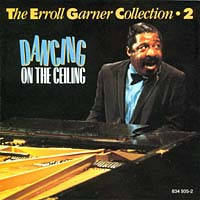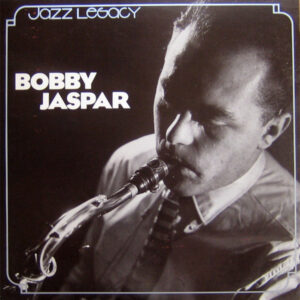Erroll Garner: The Erroll Garner Collection 2 – Dancing On The Ceiling
Vinyl | 5,00 €
Media Condition: Near Mint (NM or M-)
Sleeve Condition: Very Good Plus (VG+)
Label: EmArcy
Released: 1989
Varasto loppu
Sleeve EX. Pickup possible at our Helsinki store (please indicate in details).
All selections previously unreleased.
It Had To Be You, After You’ve Gone, What Is This Thing Called Love recorded June 1, 1961, NYC.
Crazy Rhythm, Our Love Is Here To Stay, Dancing On The Ceiling, There Will Never Be Another You, Like Home recorded July 14, 1961, NYC.
Don’t Blame Me recorded August 3, 1961, NYC.
Whispering recorded August 19, 1965, NYC.
+++++
Notes on this Production (from the back cover)
This album, the second in the series of previously unissued recordings by Erroll Garner, covers a span of output from 1961-65. The rhythm section of Kelly Martin, on drums, and bassist Eddie Calhoun, appears on all of the tracks.
As with Easy To Love, the first album in this collection, the dilemma was one of making choices from the abundant and extraordinary Garner recordings in the vaults, still awaiting their first public exposure. Following the release of Easy To Love, critic Gary Giddins asked me why the recordings weren’t issued in the 60’s when they were recorded, since they are of such prime quality. A good question. Quite simply, Garner recorded so prolifically that in a standard three hour session, he would play, improvising non-stop (usually one-takes), enough material for several outstanding albums. Sometimes, as Erroll said “the piano got so good” to him that he wouldn’t let go, or stop. (I still have vivid memories of the engineers frantically trying to change reels as Erroll rolled on, without pause.) Thus, the recordings stockpiled, and there is much glorious material yet to come.
Easy To Love has won accolades and exciting reactions: “These are prime cuts… irrepressible, ever-surprising, ever-delighting … deep… some of the greatest things Erroll Garner ever did.” – Boston Globe. “… the tracks on Easy To Love are superior reflections of the Garner genius… a sparkling heirloom.” – Sacramento Bee. “… lavish, surprising, thrilling clear music – incendiary, multi-rhythmed… conveging titanic joy, epic tenderness… Garner embraced life in every note he played.” – People Magazine.
Dancing On The Ceiling continues to tap this mother lode of Garner’s work, and again, marks his unique, and ongoing impact in the music firmament.
— Martha Glaser
+++++
Liner notes by James Isaacs (from the back cover)
The jazz world is not nearly so populated by autodidacts as the outside world would like to believe. Even in a milieu where split-second spontaneity is common currency, there are precious few “naturals.” Of such blessed artists, three spring to mind: Buddy Rich, Wes Montgomery, and above all, Erroll Garner, for whom, some wag once wrote, “the piano was invented.”
Garner sat down at the keyboard for the first time at age three at his family’s home in Pittsburgh and didn’t stop until his death fifty years later. During that half century he created, to appropriate the title of Magritte’s famous surrealist painting, an “empire of light.”
Happily, like Rich and to a somewhat lesser degree, Montgomery, Garner was one of very few improvisors who enjoyed both popular and critical favor. How many pianists can claim to have splendidly bolstered Charlie Parker on one of Bird’s all-time swingers (1947’s Cool Blues) and wowed my grandmother sometime during the mid-to-late ’50s – hers and this century’s – at the Embers in New York?
In clubs and concert halls and on numerous LPs and television shows Garner, who read nary a note but whose ear was as encyclopedic as it was acute, enraptured his listeners with flashing odes to joy and swelling, smoldering ballads. (For greater illumination of Garner’s sui generis pianistics, proceed as soon as possible to Easy To Love, Emarcy 832 994-1/2/4, whose annotation by Dudley Moore, surely the Grand Vizier of the fictitious OCTAVE – Organization Celebrating, Touting, And Venerating Erroll – are exhaustive and expert.)
Dancing On The Ceiling adds eleven new pieces to the Garner Museum. Of course, the man’s sheer vitality and force of personality assure us that these are hardly museum pieces, though the Garner orthodoxy has since been supplemented by those of Oscar Peterson, Bill Evans, McCoy Tyner, Herbie Hancock, and Keith Jarrett. But the very name of Rodgers and Hart’s tune that serves as the title selection here seems a perfect evocation of Erroll’s orchestral sound and effervescent rhythms, as well as the mood elevation they induced.
Unlike most other pianists, Garner, I understand, was not obsessively protective of his invaluable hands. “He usually wouldn’t even wear gloves in the winter,” a friend of his recalled. “He’d arrive at the club or concert hall, blow on his hands and shake them.” When asked by a writer how he’d warm up to play, Garner briefly considered the question and replied, “I’d just think – ‘Fingers, do your number!'”
And what fingers! Relatively short but remarkably flexible, they built tremolos of spellbinding tension which melted into sweet release; hit a groove faster than anyone with the possible exception of Wynton Kelly (whose serendipitous work owed much to Garner’s); and embroidered melodies from Broadway, Hollywood, Tin Pan Alley, and his own right brain, while his left hand played, in effect, the niftiest rhythm guitar outside of Freddie Green.
Listen to how he introduces the venerable It Had To Be You, one of the six numbers herein he had recorded previously. Striking twenty-two playfully dissonant chords, unusually arranged in groups of four, eight, and ten, it’s as if he’s rousing a dozing geezer from his chair and onto the dance floor. Then we’re again on terra firma, thanks to that renowned left hand, while the right once more places its owner on the board of governors, with Lester Young, Hank Mobley, and, more recently, Willie Nelson, of the Tantalizingly Behind The Beat Society.
There are many similarly typical pleasures in this package: the intro to Crazy Rhythm, full of comically schizzy contrasts; the allusive finger-pointing to “Louise” as the one who’s jilted him in After You’ve Gone — and the locked hands, double-time flourish at the tune’s climax; the stride and stutter-step at the beginning of Our Love Is Here
To Stay; the urbane blues and sustained late-night mood of his blues, Like Home; the sexy rhumba that is What Is This Thing Called Love?
And one should also salute the contributions of Eddie Calhoun and Kelly Martin, whose decade in the service of Garner made them his longest-running bass-drum team. The steady pulse of Calhoun’s bass and the whisk of Martin’s brushes amounted to the sort of selfless support that, as a friend put it, might be likened to holding the net for the highest-flying Wallenda.
It is fitting that the program closes with a brisk Ain’t Misbehavin’; the bonus cut on the CD. The tune’s composer, Fats Waller, was, like Garner, an undisputed keyboard giant, a highly gifted composer, many of whose songs are now standards, and a much loved performer.
One envisions Erroll at his Baldwin, boosted on the bench by his faithful Manhattan telephone directory, grunting and growling on the off-beats. One wishes that he could forever be at the center of such a congenial tableau.
But he is gone a dozen years – to this very day, as a matter of sad fact. Here are eleven more reasons for us to miss him.
— James Isaacs January 2, 1989
| Paino | 230 g (gramma) |
|---|---|
| Genre | Jazz |
| Style | Bop,Swing,Cool Jazz |
| Condition | Near Mint (NM or M-) |
| Formaatti | Vinyl |


